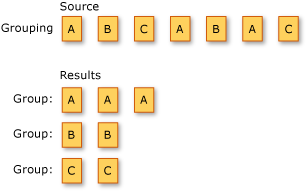Grouping Data (Visual Basic)
Grouping refers to the operation of putting data into groups so that the elements in each group share a common attribute.
The following illustration shows the results of grouping a sequence of characters. The key for each group is the character.

The standard query operator methods that group data elements are listed in the following section.
Methods
| Method Name | Description | Visual Basic Query Expression Syntax | More Information |
|---|---|---|---|
| GroupBy | Groups elements that share a common attribute. Each group is represented by an IGrouping<TKey,TElement> object. | Group … By … Into … |
Enumerable.GroupBy Queryable.GroupBy |
| ToLookup | Inserts elements into a Lookup<TKey,TElement> (a one-to-many dictionary) based on a key selector function. | Not applicable. | Enumerable.ToLookup |
Query Expression Syntax Example
The following code example uses the Group By clause to group integers in a list according to whether they are even or odd.
Dim numbers As New System.Collections.Generic.List(Of Integer)(
New Integer() {35, 44, 200, 84, 3987, 4, 199, 329, 446, 208})
Dim query = From number In numbers
Group By Remainder = (number Mod 2) Into Group
Dim sb As New System.Text.StringBuilder()
For Each group In query
sb.AppendLine(If(group.Remainder = 0, vbCrLf & "Even numbers:", vbCrLf & "Odd numbers:"))
For Each num In group.Group
sb.AppendLine(num)
Next
Next
' Display the results.
MsgBox(sb.ToString())
' This code produces the following output:
' Odd numbers:
' 35
' 3987
' 199
' 329
' Even numbers:
' 44
' 200
' 84
' 4
' 446
' 208
See also
Feedback
Coming soon: Throughout 2024 we will be phasing out GitHub Issues as the feedback mechanism for content and replacing it with a new feedback system. For more information see: https://aka.ms/ContentUserFeedback.
Submit and view feedback for
